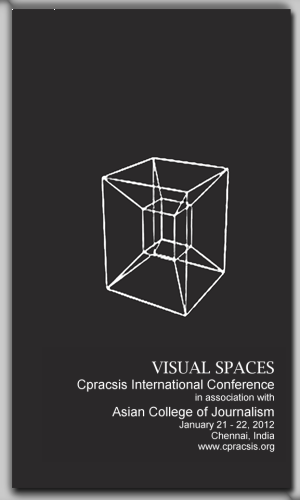 |
"The space of our primary perception, the space of our dreams and that of our passions hold within themselves qualities that seem intrinsic: there is a light, ethereal, transparent space, or again a dark, rough, encumbered space; a space from above, of summits, or on the contrary a space from below of mud; or again a space that can be flowing like sparkling water, or space that is fixed, congealed, like stone or crystal."
—Michael Foucault, "Other Spaces"
Space, as Foucault observes, can no longer be seen simply as an empty backdrop against which beings, events and things fold and unfold. Rather it is a dynamic entity, with a unique history and kinetic characteristics, displaying the potential for evolution, mutation, transformation and obliteration. In short, space itself is a being, an event, a site. The concept of visual space envisages a wide variety of ideas, notions, theoretical premises and deliberations evolving within the purview of visual culture, which is an open ended and interdisciplinary interplay of images. For instance the cultural significations of space, when defined as performance space, cinematic space, mediated space, architectural space and virtual space get subjected to a spectacularly radical transition in comparison with the conventional interrelations of space. In a sense, visual space can sometimes be viewed as heterotopias and as locations of scopic otherness and introgression. This concept is formulated in congregation with the prevalent fascination with the ways of seeing and the explosion of visual experience which effected in a "paradigm shift in the cultural imaginary of our age" as Martin Jay suggested. The concept of visual space also attempts to signify the visualizations of the things which do not naturally come under the rubric of vision. Martin Heidegger's notion of the 'world picture' as the world 'conceived and grasped as a picture' articulates the complex rendering of experience. For Lefebvre, the connection between seeing and not seeing defines everyday life and more precisely, l'existence. Gaston Bachelard's phenomenal work on space explains imagination as a perpetual dialogue between the human subject which imagines and the image itself. Further, in Guy Debord, everyday life presents itself as an extensive accumulation of spectacles where modern conditions of production prevail. From such a perspective, spectacle is not simply a collection of images, but social relations mediated and materialized by and through images. Also, there is this remarkable vision of Donna Haraway that vision is ultimately a matter of power and positions. Maurice Merleau-Ponty, has devised that the organization of spaces is in profound resonance with the human body, its shape and its capacities. Visual is not just the visible; the notion of visual space dismantles all characteristics of habitual visual perception and thus brings to light the visuality of the invisible. The central thematic of the conference pivots on questions such as "How/why are visual spaces organized?", "How is vision constituted in relation to space?" and "How are practices of seeing formulated in the spatial matrix?". It also attempts to evince nuances of methodological explorations in the organization of space and orientation of vision by raising issues such as:
- Performance Spaces, Stages and Non-stages Dance
- Cultures/Rituals/Theatres
- Architectural Spaces
- Graffiti/Sequential Narrative Space/Comics
- Media/mediated Spaces; Radio and Television/Cinematic Space
- New Media, Virtual Culture and Cyber Spaces
- Printed Spaces, Discursive Spaces
- Spaces of the Differently abled
- Sexuality and Visual Spaces
- Monarchic, Feudal, Capitalist spaces
- Caste, ethnicity and religion
- Village, Small Township, City, Metropolis
- Nation, Nationality, Subnational and Transnational Spaces
- Diasporic Spaces, Migrations and Movement
- Sports/Game/Recreational Spaces
- War Spaces, War Museums, Memorials
- Neo-nomadic/ Revolutionary/ Encroached/ Impoverished Spaces
- Academic and Administrative Spaces
- Colonial, Post-colonial, Global Spaces
- Navigational Spaces, Imperialism and Modernity
- The Void/Infinite Space/Future Space/No-spaces
The Asian College of Journalism is South Asia's premier institution of journalism education. The College was set up and is administered by the Media Development Foundation, a not-for-profit Public Trust. |